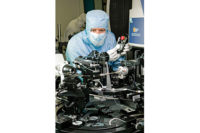Ten Easy Ways to Destroy Sensors

Intense heat and flame make welding a harsh process. As a result, manufacturers often spend thousands of dollars replacing sensors that are damaged or destroyed.
Ravenous consumption of sensors in welding cells is largely preventable. Unfortunately, many companies don't take the time to address the root cause of the individual problems or failures.
Some engineers nonchalantly expect to purchase more than $5,000 worth of sensors every month. Plant maintenance personnel spend an equally large amount of time and energy replacing them. But, despite such waste, it's an accepted practice at many manufacturers.
Inductive proximity, photoelectric and magnetic field through-the-wall clamping cylinder sensors are the most common sensors found in robotic and semiautomated welding cells. All these are noncontact electronic devices.
Sensors intended for less demanding assembly or material handling applications are not appropriate for a welding cell full of extreme temperature bursts and weld spatter. Those harsh conditions eat sensors and wiring for lunch.
Yet such sensors are commonly found during weld cell audits, and the results are not pretty. It's not unusual to see the plastic faces of standard inductive proximity sensors melted away with the coils exposed; plastic mounts chewed to smithereens; cylinder clamping sensors vaporized; and the optical faces of photoelectric sensors rendered useless because of abuse.
The Path to Destruction
For any type of welding application, there are nine common ways to destroy sensors:
- Pick the cheapest, generic sensor to place in a welding cell and watch the standard plastic face disappear.
- Don't bunker, protect or provide a means of rapid change-out for your sensors. Use the cheapest, daintiest plastic C-style mounting cuff that leaves the sensor body exposed to the worst hostilities found in the welding process.
- Integrate the cheapest connectors you can find with the wrong jacketing material. Don't use right-hand exit configurations that relieve the tension on the connector, which can prematurely kill it at the strain relief site. And, leave the connector totally exposed to the most hostile conditions you have.
- Fail to consider the extremes of loading impacts from components in a welding cell, and leave the sensors exposed to the crushing effects of loading.
- Expose your gripper sensors so when the jaws close, the sensor acts as a dead stop with every hit.
- Put photoelectric sensors looking in an "up" position that exposes them to all weld hostilities and don't protect plastic photocell bodies. Make sure weld debris finds it's way to the lens so it degrades quickly.
- Don't use modern coatings on sensor faces and sensor enclosure bodies. These coatings provide a thermal barrier, repel weld spatter and allow for removal of debris during maintenance periods. For added fun, watch weld debris accumulate on a noncoated sensor that eventually false-triggers the sensing device, then watch the operators scramble.
- Bury sensors so deep in the welding cell that they take at least a half hour to locate, repair, clean or replace after sections of the tool have to be removed and reinstalled.
- Put noncoated, ordinary inductive sensors right up against the hottest part of the cell that you can find. For instance, even if the sensor is only rated to 70 C, and the weld location exceeds 140 C, don't worry. If anything's left, you can always replace it later on.
Sensor Salvation
Of course, destroying sensors on purpose doesn't make any sense, unless production time and cost are no objective. In today's competitive climate, that's not something manufacturing engineers should strive for.
Integrating a few corrective measures can dramatically reduce sensor consumption and greatly extend the life of these devices. Even in the most rigorous welding environments, improvements of between 15 percent and 70 percent in reduction of sensor-related costs are possible if engineers follow these simple tips:
- Bunkering and heavy mounting will act as a heat sink for sensors, greatly protecting those devices and resisting even the heaviest loading impact.
- Correct gapping and alignment of sensors can minimize impact on sensors, which are noncontact devices. Adjustable mounts that hold sensors will allow you to take full advantage of any sensor's inherent sensing range. They also provide a means of rapid change out when replacement time rolls around.
- Choosing the right application-specific sensor for the right function it must perform is imperative in welding environments. Put the wrong device in the application, and the outcome is totally predictable.
- New protective coatings designed for sensor faces and enclosures greatly insulate the sensor with a thermal barrier, repel weld debris and make it easier to remove accumulated spatter.
- Integrating photoelectric sensors takes a little thought and consideration in weld cells. Correct bunkering and mounting with photocells is imperative. Many photocell bodies are plastic. Also, ambient light properties vary from cell to cell, and from company to company, thus affecting reflectivity from targets.
- New connector jacketing material extends sensor longevity. For instance, by covering a connector with a medical-grade silicone, you can eliminate burn-through problems-even when joining extremely heavy steel.
- Repeatable, consistent sensing in welding cells using fiber optics is largely undependable. One speck of debris on fiber optic lenses can render the sensor useless. Consider using alternative off-the-shelf photoelectric alternatives to fiber.
Looking for a reprint of this article?
From high-res PDFs to custom plaques, order your copy today!



